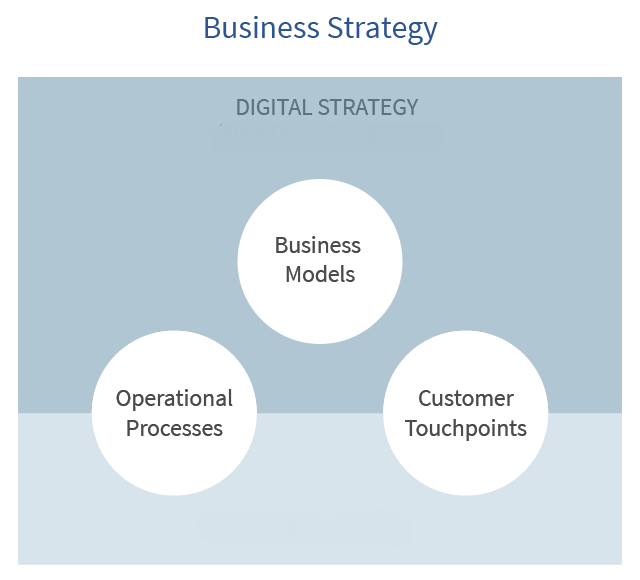Digital strategy focuses on using technology to improve business performance, whether that means creating new products or reimagining current processes
Evolving the Definition of Business Strategy
Digital strategy focuses on using technology to improve business performance, whether that means creating new products or reimagining current processes. It specifies the direction an organization will take to create new competitive advantages with technology, as well as the tactics it will use to achieve these changes. This usually includes changes to business models, as new technology makes it possible for innovative companies to provide services that weren’t previously possible.
Today, technology has integrated with business to become something more than hardware or software. As digital technology becomes more pervasive and companies move further in the journey of digital transformation, digital strategy and business strategy will be the same thing. For now, it is still useful to use the term to focus the effort behind digital initiatives.
Definition of Business Strategy
It’s important to remember that digital strategy is both a concept and a thing — that is, a digital strategy should eventually lead to the creation of a concrete plan or roadmap. While you can keep changing the specific tactics you’ve decided to pursue, there should also be a clear commitment to your understanding of what digital means for your company.
As an example, say your digital strategy (ultimate goal) is to monetize basic productivity software that your business has already developed and uses internally. At first, you lay out a strategy (plan) to package it as a mobile app and sell it to individual users. Later, you realize that it has more value if you sell it to businesses to incorporate into their own mobile apps. Your strategy (ultimate goal) didn’t change, but your strategy (plan) did. Changing the guiding idea of your digital strategy should amount to a big shift or reorientation for your company, but ideally, the concrete steps will be flexible enough to allow you to pivot as needed.
Digital in the Context of Digital Transformation

There is a tendency to talk about digital transformation interchangeably with digital strategy. The two terms are closely related, but differ in scope. Digital transformation drives change in three areas: customer experience, operational processes and business models. The process of digital transformation requires coordination across the entire organization, and involves business culture changes.
Digital strategy, on the other hand, focuses on technology, not culture. Digital strategy is most relevant to changes in business models, and uses technology to create the capabilities a company needs to become a digital business. Setting down a strategy is a key component of the transformation process, and ensures that technology is being implemented in a way that supports the business objectives.
Where to Start
How do you build a digital strategy? Rather than asking, “What’s our digital strategy?”, an article from Harvard Business Review suggests using the five following questions to ground your understanding of digital technology:
- Does digital technology change the businesses you should be in?
- How could digital technology improve the way you add value to the businesses you are in?
- Could digital technology change your target customer?
- Does digital technology affect the value proposition to your target customer?
- How can digital technology enhance the enterprise capabilities that differentiate you from your competition?
To some companies, these questions will have obvious answers, especially those that have already experienced disruption or competition from new digital players. The intention is to identify how digital changes what you do, and then refine your understanding from broad industry trends to specific values that will form the foundation of your strategy. By beginning with a clear understanding of your company’s purpose, you can avoid wasting time and resources implementing technology that doesn’t enable new competitive advantages.
Common Elements of Strategy
- Choose a Leader — This is arguably the most important part of creating a digital strategy, but choosing the right person will depend on company culture, structure and priorities. Whether companies place leadership with the CEO or an appointed Chief Digital Officer, the leader’s influence will need to match the scope of digital strategy; otherwise, it will be difficult to create the full buy-in from each department necessary to make effective changes.
- Attack vs. Defend — McKinsey & Company emphasizes that companies would do well to categorize their potential threats and opportunities in digital business, then compare these against their own purpose. This clarifies whether a proactive or defensive stance needs to guide new initiatives.
- Take a Measured Approach — Digital strategy often incorporates a process for assessing whether new technology will really complement or grow the current business. If you fear that your company is already behind on digital, it can be tempting to rush into a project without looking at how it fits your current strategy. By taking a measured approach, you can avoid wasting resources on initiatives that don’t align with your business’s needs and priorities.
- Future Proof — The goal of digital transformation is to create an appropriate foundation for digital business. This means creating an organization that can continue to reinvent itself as necessary to keep up with changes in technology and customer expectations. Digital strategy should be visionary enough to carry companies through changes in the digital economy, in a way that continues to bring a digital edge to the business.

Leave a Reply